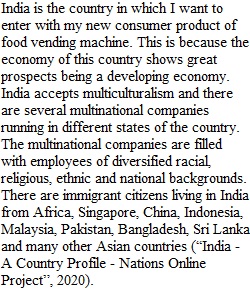


Q MKT 608 1 CULTURAL ANALYSIS The data obtained for this cultural analysis provides vital information to guide development of the business plan and to support managers in understanding specific cultural dimensions of the country. Such information is useful to ensure the firm is effective in both developing the plan and interacting with the target market. Hence the information developed for this section serves a dual purpose both in the early stages of developing the plan and in executing the plan through interactions with country nationals. The information in this section constitute more than simple facts. Managers responsible for developing and executing the plan should attempt to interpret how the information developed in this section affect the firm’s product, its adaptation (if needed) for the target market, and how the product should be offered in the target market. For example, the fact that China is characterized by Confucianism and guanxi is interesting, but the manager must attempt to understanding how such constructs influence various aspects of market behavior. • The headings in each section are general and intended to provide direction to areas to explore for relevant data. Heading topic area may be emphasized or de-emphasized, depending on the nature of the firm’s product and the country being targeted. Some topic headings are unimportant for some countries and can be ignored, but needs to be explained for the reasons of omission. • A student will conduct secondary research on the cultural environments outlined in “The Country Snapshot”. • The written report should include all of the case components noted in the appendix 1 and should be about 5 to 10 single-spaced pages long, 12-font size, 1-inch margin (excluding appendices and references). MKT 608 2 a. Introduction Include a short profile of the country with which you wish to enter. b. History (brief discussion of the country’s relevant history - less than one page long) c. Geographical Setting (especially location, topography, and climate) d. Social Institutions - Family (nature and role the family; nature of male/female roles) - Education (literacy rates; role and quality of education, at all levels) - Political System (especially type of political system and structure; political parties; government stability; how this is evolving over time) - Legal System (code, common, socialist, or Islamic; intellectual property law; quality of legal and regulatory environment for facilitating business) - Social Organizations - Group Behavior (is country relatively individualistic or collectivist in its orientation?) - Social Classes (including the role of social classes, if any, in organization of society) - Race, Ethnicity, and Subcultures - Business Customs and Practices (very important; elaborate this!) e. Religion - Religion and Other Belief Systems - Role of Religion in Society and Business (this may or may not be relevant, depending on country; usually a factor in Israel; Middle East; and South Asia) f. Living Conditions - Diet and Nutrition, including typical meals and popular foods Housing, including typical housing (apartments, homes, or other) - Clothing, including types of clothing worn at work and for leisure - Recreation, Sports, and Other Leisure Activities, if relevant - Social Security or other Pension Systems - Health Care, including type of health care system, quality of health care - Other Entitlements, if relevant g. Language(s) MKT 608 3 h. References (required) Appendixes for this section (Include here any useful supplementary material such as, for example, helpful tables or charts, reports specific to the industry or market, news articles that are particularly relevant to the company or industry.) REFERENCES Sources of Information for the entire document (REQUIRED) (Don’t forget to track references. Don’t plagiarize! It’s okay to use someone else’s work as long as you cite it and as long as you quote it, if it’s a direct quotation. Put all cited references in the Reference section here.) Source: Adapted from Cateora, Philip, Mary Gilly, and John Graham (2010), International Marketing, 15th ed. New York: Irwin McGraw-Hill HOW TO WRITE A REFERENCES SECTION: EXAMPLES Books: Douglas, S.P. and Craig, C.S. (2008) International Marketing Research, Englewood Cliffs, NJ: Prentice-Hall. World Bank (2012) World Development Indicators, Washington, DC: The World Bank. Articles: Smith, S. (2012) "The New Economy: What It Really Means," Business Week, November 17, pp. 27-31. Knight, G. (1995) "International Marketing Blunders by American Firms in Japan - Some Lessons for Management," Journal of International Marketing, Vol. 3, No. 4, pp. 107-129. Reports: UNCTAD (2013) World Investment Report 2012, New York: United Nations: United Nations Conference on Trade and Development. Internet Sites: MKT 608 4 Central Intelligence Agency (2001) The World Factbook 2012 (http://www.odci.gov/cia/publications/factbook/index.html), Washington, DC: Central Intelligence Agency. Hoover’s, Inc. (2012) Hoover’s Online (http://www.hoovers.com), Austin, TX: Hoover’s, Inc. Jupiter Communications Inc. (http://www.jup.com), New York, NY.
View Related Questions